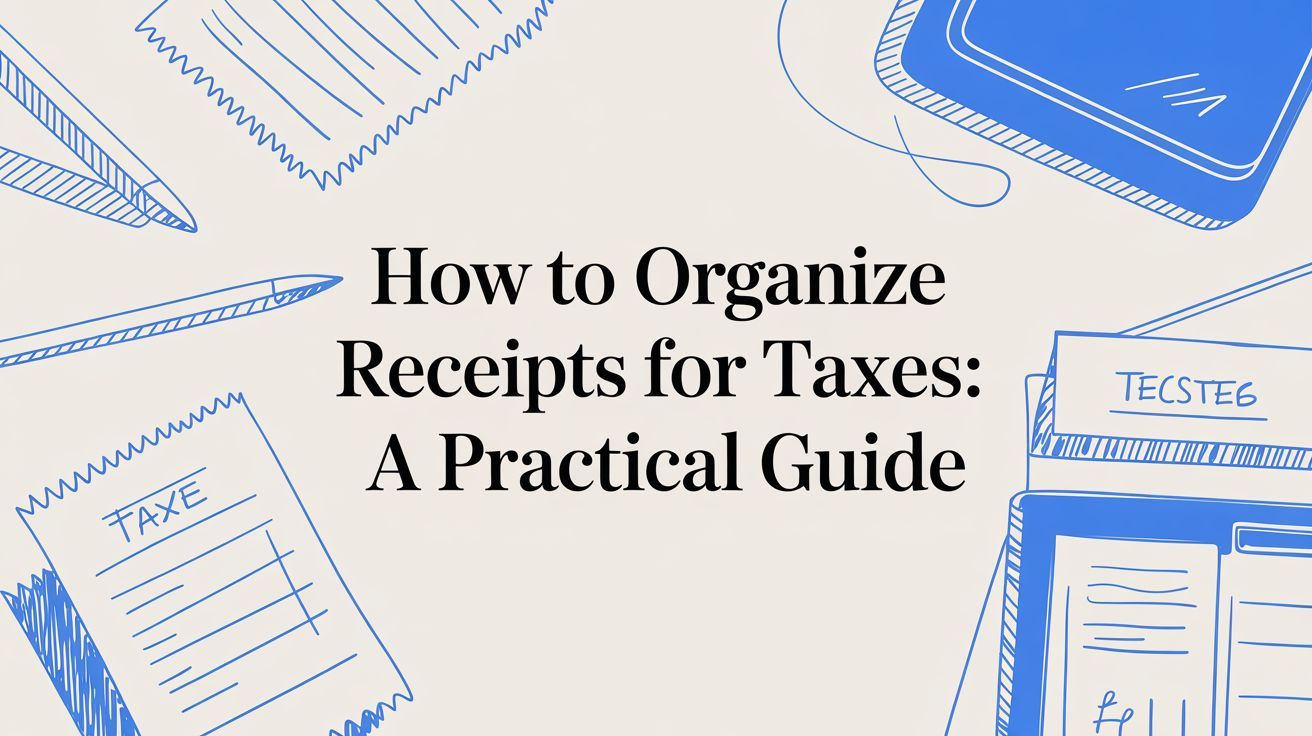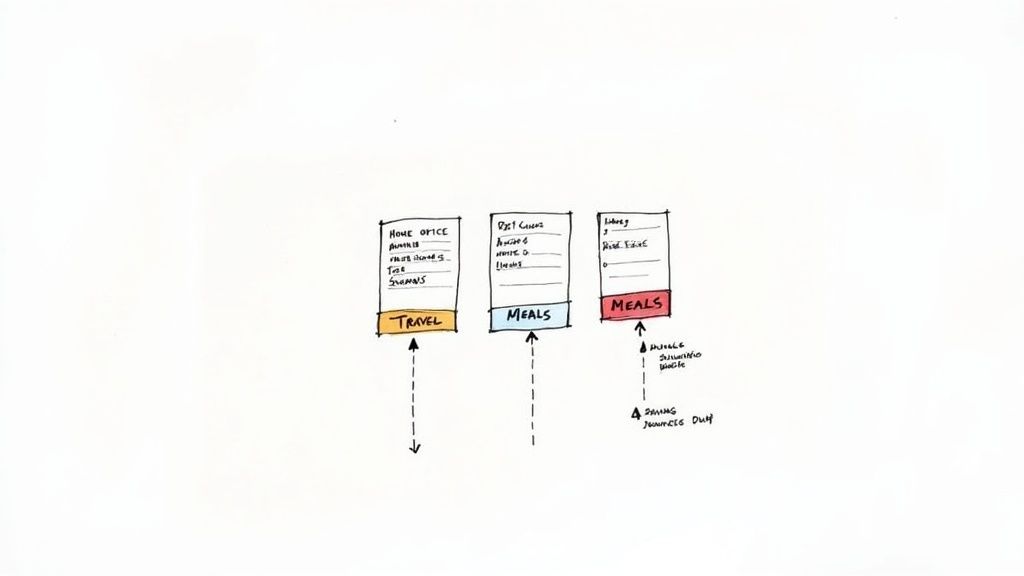
How to organize receipts for taxes: A Practical Guide
Organizing receipts for taxes isn’t just piling up papers—it’s about building a reliable routine to collect, categorize, and store every expense, whether it’s a crumpled café slip or a PDF invoice. Nail this, and you’ll breeze through deductions, boost your refund, and sidestep audit headaches.
Why Organized Receipts Are Your Financial Superpower
Tax time can feel like a scavenger hunt for fading scraps and forgotten emails. Yet this annual scramble actually offers a chance to sharpen your financial discipline and capture every dollar you’ve spent.

Maximize Every Deduction
Small expenses often slip through the cracks, but they add up fast. A single client coffee might seem trivial—until you total a year’s worth of latte meetups.
- Keep a running log or photo archive on your phone
- Tag each item by category (meals, supplies, travel)
- Revisit your list monthly to avoid last-minute surprises
Gain Audit-Proof Confidence
Nothing beats the peace of mind that comes with a date-stamped, well-organized file. In fact, sloppy record-keeping can cost businesses up to 10% of valid write-offs. When every receipt is in order, you’re ready for an IRS audit without breaking a sweat. For deeper research, explore insights at the Wharton School.
A simple, chronological receipt system transforms tax season from a frantic scramble into a calm, controlled review.
This isn’t just box-checking. It’s setting up a year-round habit that keeps your finances crystal clear—long before April arrives.
Building Your Receipt Collection Workflow
The hardest part of getting your receipts organized for taxes? Just getting started. The secret is building a simple, repeatable habit to catch every single receipt, whether it's a paper slip or a digital invoice.
For physical receipts, you need a single, non-negotiable "inbox." This could be a specific tray on your desk, a small box you keep in your car's glove compartment, or even a dedicated pocket in your work bag. The moment you get a paper receipt, it goes straight there. No exceptions. This tiny habit is what keeps those important slips from vanishing into the laundry or getting buried on your desk.
Taming Your Digital Receipts
Digital receipts need the same kind of discipline. Go into your email client right now and create a new folder called "Tax Receipts." Better yet, set up a simple filter to automatically move any email containing words like "receipt," "invoice," or "order confirmation" into that folder. It keeps your main inbox clutter-free and corrals everything in one spot.
Don't worry about perfect organization at this stage. The only goal here is to create a central holding pen for everything.
A messy folder of receipts is infinitely better than a collection of lost ones. Just focus on gathering everything first. The sorting comes later.
The Crucial First Sort
Once you have a collection point, block off a little time every week or two to do the most important first step: splitting business expenses from personal ones. This one action immediately makes the whole task feel less overwhelming. For anyone running their own business or freelancing, getting this right is absolutely critical for accurate bookkeeping.
This process is the foundation of a solid system. As you get more comfortable, you can explore ways to improve your process by digging into concepts like document workflow automation to see how much of this you can put on autopilot.
As you do your initial sort, make these two actions a habit:
- Snap a Photo: For every single paper receipt, take a clear picture with your phone. The IRS is perfectly happy with digital copies, and this is your backup when the thermal paper inevitably fades to blank.
- Add Quick Notes: Before you file it, scribble the business purpose right on the receipt (or in the filename of the digital copy). Something like, "Lunch with Client Jane Doe - Project Alpha" provides crucial context you'll be grateful for months down the line.
Finding a Receipt Organization System That Actually Works for You
Let's be honest: the best system for organizing your receipts is the one you'll actually stick with. There's no single "right" way to do it. What works for a freelance designer might not work for a contractor who's always on the road. The goal is to find a workflow that feels natural for you and your business, so you can keep it up all year long.
For some people, there's just something about physical paper. An old-school accordion file or a few labeled manila folders—one for office supplies, one for travel, you get the idea—can be incredibly effective. It's simple, straightforward, and doesn't require learning any new tech. If you go this route, get into the habit of scribbling the business purpose on the receipt the moment you get it. Your future self will thank you.
Why Going Digital is More Than Just a Trend
Still, there’s a reason most of us have moved our record-keeping online. It's not just about being modern; it's about being practical. A recent Deloitte survey of over 1,100 tax executives highlighted just how critical digital tools have become for staying compliant.
When your receipts are digital, they’re searchable, they're backed up, and they won't fade into illegibility in a year. This can be as simple as having a dedicated folder in your Google Drive or Dropbox where you toss photos or scans of your receipts.
A good way to think about a simple digital workflow breaks down into three key actions.

This simple process—capture, separate, and organize—is what transforms that dreaded shoebox of paper into clean, usable data when tax season rolls around.
Let Automation Do the Heavy Lifting
This is where a digital system really shines. Instead of just storing pictures of receipts, you can use tools that actually read them for you.
Your goal should be to handle each receipt just once. Capture it, let technology extract the data, and file it away permanently.
Tools like DocParseMagic take this a huge step further. They don't just scan; they parse the information. That means the software automatically identifies and pulls out the key details—vendor name, date, total amount—and drops it all neatly into a spreadsheet. Think about the hours of mind-numbing data entry that saves you. Plus, it nearly eliminates the chance of typos. Finding the right document management software for small businesses can be a complete game-changer for your bookkeeping.
Comparing Receipt Organization Methods
So, what's the verdict? Physical, digital, or a mix of both? Each approach has its own strengths and weaknesses. This table breaks it down to help you see what might fit you best.
| Method | Pros | Cons | Best For |
|---|---|---|---|
| Physical | Simple, low-tech, and tangible. No software to learn. | Prone to loss, damage, or fading. No search function. | Solopreneurs with very few expenses or those who prefer a hands-on approach. |
| Digital | Searchable, secure, and accessible from anywhere. | Can require a consistent scanning habit. Potential for software costs. | Most businesses, especially those with multiple expense categories or a high volume of receipts. |
| Hybrid | Combines the simplicity of a physical inbox with the power of digital storage. | Requires an extra step (scanning) to bridge the two systems. | People who want the best of both worlds—an easy way to collect paper receipts but with the security and convenience of a digital archive. |
Ultimately, many people land on a hybrid system. They might have a physical tray on their desk for incoming paper receipts but make it a Friday afternoon ritual to scan everything into their digital system. It's a great compromise that gives you a simple collection method backed by the power, security, and searchability of a digital archive.
Categorizing Expenses to Maximize Your Deductions
This is where all your hard work collecting receipts really starts to pay off. It’s one thing to have a shoebox or a digital folder stuffed with receipts, but it’s another to turn them into actual tax deductions. Correctly categorizing each expense is what translates those little slips of paper into real money back in your pocket.

Why is this so important? Globally, tax authorities are paying closer attention to how businesses report expenses. With tax revenues making up around 30% of GDP in many OECD countries, it's easy to see why they want everyone to get it right. You can read more on these global revenue statistics from the OECD.
Demystifying Common Business Expense Categories
If you're a freelancer or run a small business, you'll find that most of your expenses fit neatly into a handful of categories. Nailing these down is the first step toward getting every deduction you're entitled to.
Here are the usual suspects you'll be working with:
- Office Supplies: This isn't just pens and paper. It’s your laptop, software subscriptions, printer ink—anything that keeps your office running.
- Travel: Think flights, hotels, rental cars, and even the mileage you track for business trips.
- Meals: That lunch where you discussed the new project with a client? That's often partially deductible.
- Professional Services: This is the bucket for payments to your accountant, lawyer, or any consultants you've hired.
- Marketing & Advertising: All those Facebook ads, your website hosting fees, and even the cost of printing business cards belong here.
The key is consistency. Pick a set of categories that makes sense for your business and stick to them. A consistent system makes it ridiculously easy to see where your money is going and ensures no write-offs slip through the cracks.
From Paper Notes to Digital Tags
So, how do you actually do the categorizing? It really depends on the system you've chosen.
If you’re still using physical folders, a quick note right on the receipt can make all the difference. Something as simple as "Lunch with Jane Doe re: Project X" adds crucial context, turning a generic receipt into a bulletproof business record.
This gets even simpler in a digital setup. Most receipt-scanning apps let you add digital "tags" or assign categories with a quick tap. The real game-changer, though, is automation. After you’ve tagged a few receipts from your local coffee shop as "Client Meals," a smart system can learn to do it for you next time.
This isn't just about saving time; it's about minimizing mistakes. By training a system to connect specific vendors or keywords to the right categories, you build a process that pretty much runs on its own. It transforms a messy pile of data into a clean, organized, and tax-ready report. You can see how this works in our guide on PDF data extraction to Excel.
Making Your System Last Beyond Tax Season
Building a receipt workflow only to abandon it after April is like buying a gym membership and never showing up. Instead, pencil in a five-minute weekly slot—think Friday afternoon—to handle new receipts. Small, consistent steps beat a last-minute marathon any day.
Over time, that brief check-in becomes second nature. Before you know it, you’ll have tidy records with minimal effort.
Creating A Sustainable Routine
I’ve found that simple guardrails keep me honest:
- Capture Immediately: Snap a photo or drop the paper in your “to-process” tray. Don’t let receipts pile up in your wallet for weeks.
- Weekly Tidy-Up: During your 5-minute window, scan any stray slips, tag each expense, and archive or recycle physical copies.
- Monthly Checkpoint: Carve out 15 minutes at month’s end to correct misfiled items, fill in missing notes, and verify categories.
By turning these actions into habit, you avoid the panic of unfiled documents as tax deadlines loom.
Your best defense on Tax Day isn’t caffeine-fueled panic—it’s the handful of minutes you spend every week.
Safeguarding Your Records For The Long Haul
The IRS usually wants records for three years after filing, but certain circumstances can stretch that to seven. Here’s what’s worked for me:
- For paper receipts, I use a fireproof, lockable box tucked in a dry corner of my home office.
- Digitally, everything lives in Google Drive with automatic backups enabled—one copy in the cloud, another on an external HDD.
This dual approach guards against spills, device crashes, and lost phones. In my experience, knowing your data is safe brings a level of calm no tax season can shake.
Lingering Questions About Organizing Tax Receipts
Even with the best system, a few tricky questions always seem to surface when you're deep in the weeds of organizing receipts for taxes. Let's clear up some of the most common ones so you can move forward with confidence.
How Long Should I Hang Onto Tax Receipts?
The standard advice from the IRS is to keep your records for three years from the date you filed your return. For most people, most of the time, this is a safe bet.
But there are a few "what ifs." If you happen to underreport your income by more than 25%, the look-back period extends to six years. Honestly, to avoid any confusion and for total peace of mind, many accountants (myself included) just recommend a simple seven-year rule for everything tax-related. It's just easier that way.
Are Digital Copies of Receipts Okay for the IRS?
Yes, absolutely. The IRS has been accepting digital or scanned copies for years, as long as they are legible and complete. This is a game-changer for anyone trying to go paperless.
Just make sure your digital copy is a good one. It needs to clearly show the vendor's name, the date, the amount you paid, and what you bought. A decent scanning app on your phone will get the job done right.
What if I Lose a Receipt? Am I Out of Luck?
It happens to everyone. A lost receipt doesn’t automatically mean a lost deduction, you just have to work a little harder to prove the expense.
Your best backup is a credit card or bank statement that shows the transaction. When you rely on a statement, I always recommend making a quick note right on it—or in your digital file—explaining the business purpose of that specific charge. An original receipt is always the gold standard, but this method is usually enough to satisfy an auditor, especially for smaller amounts.
Can I Still Deduct Expenses I Paid for with Cash?
You can, but it requires you to be extra diligent. Cash transactions don't leave that clean, automatic trail that a credit card does.
The best habit you can build is to get a receipt for every single cash purchase, no matter how small. If a vendor can't give you one, you need to create your own record immediately. Jot it down in a notebook or a digital app—record the date, amount, vendor, and a clear description of the business purpose. The closer you make that note to the time of purchase, the stronger your claim will be.
Tired of squinting at receipts and typing everything into a spreadsheet by hand? DocParseMagic uses AI to instantly grab all the important details and organizes it for you. It can save you a ton of time. Give it a try for free and see how it works.